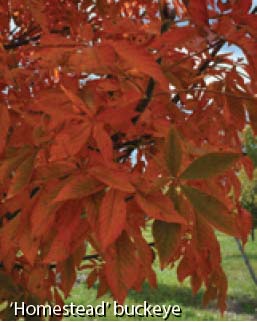|
News
|
|
Tuesday, October 27, 2015 01:00 PM |
|
 If you are looking to replace trees lost in last fall’s severe freeze, horticulturists at CSU have 8 cold-hardy suggestions that survived the rapid temperature changes of November 2014. During several years of observation by the CSU team, all 8 trees have proven reliable at elevations of 4,000 to 6,000 ft. Most have multiple seasons of interest and some appear to be pest and disease free. If you are looking to replace trees lost in last fall’s severe freeze, horticulturists at CSU have 8 cold-hardy suggestions that survived the rapid temperature changes of November 2014. During several years of observation by the CSU team, all 8 trees have proven reliable at elevations of 4,000 to 6,000 ft. Most have multiple seasons of interest and some appear to be pest and disease free.
Queen Elizabeth Hedge Maple – small to medium sized tree suited for dry sites with more alkaline soil. Place where a smaller tree is needed. Foliage stays green late in the year and turns yellow in the fall.
Arrowhead sugar maple seems to be pest and disease free. Offers dense branching and excellent bright red to orange fall foliage.
Homestead buckeye is also pest and disease free. Has dense, rounded crown, has cream-colored flowers and dark red to orange fall foliage.
Crimson frost birch features purple leaves that contrast with its white bark. Branches begin to weep quickly after planting. Adds unique color and shape to the landscape, but requires more moisture than most on the list.
Katsura Tree offers interesting foliage changes. Leaves emerge in spring with reddish purple hue, fade to blue-green and turn golden yellow in the fall. Before leaves drop in the fall, they smell like toasted marshmallows. Also requires more water than most tress on the list.
American yellowwood is named for the yellow color of its heartwood. Showy flowers that emerge in May and June are attractive and fragrant. Recommended as a nice looking, but underutilized tree for the Front Range.
Turkish filbert is another underutilized tree that is a good choice for urban areas because it tolerates a variety of conditions and has few known pest problems. Foliage is dark green in the summer.
Prairie Gem is a cultivar of Ussurian pear with a smaller mature size. Flowers emerge early at the same time as leaves. Requires least moisture of the trees listed.
To read more about these trees and see photos of each, see the September-October issue of Colorado Green, now available online for ALCC members.
Read more in this issue of Colorado Green NOW:
Top awards come home to Colorado
Current staff can be key to the recruitment process
Will your business be subject to ACA's "Cadillac tax"?
Using recycled glass in the landscape
|

